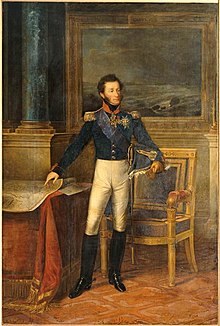Louis-Antoine, Duke of Angouleme
| Louis Antoine | |
|---|---|

Louis Antoine, Duke of Angoulême
(by François Kinson, 1825) |
|
|
King of France and Navarre (disputed) as Louis XIX |
|
| Tenure | 2 August 1830 (approx. 20 min.) (Non proclaimed) |
| Predecessor | Charles X |
| Successor |
Henry V (non proclaimed) Louis Philippe I as King of the French |
| Legitimist pretender to the French throne | |
| Pretendence | 6 November 1836 – 3 June 1844 |
| Predecessor | Charles X |
| Successor | Henry V |
| Born |
6 August 1775 Palace of Versailles, France |
| Died | 3 June 1844 (aged 68) Gorizia, then Austrian Empire (now in Italy) |
| Burial | Kostanjevica Monastery, now in Nova Gorica, Slovenia |
| Spouse | Marie Thérèse of France |
| House | Bourbon |
| Father | Charles X |
| Mother | Marie Thérèse of Savoie |
| Religion | Catholicism |
| Signature | |
Louis Antoine of France, Duke of Angoulême (6 August 1775 – 3 June 1844) was the eldest son of Charles X of France and the last Dauphin of France from 1824 to 1830. He was technically King of France for less than 20 minutes before he himself abdicated, due to his father's abdication during the July Revolution in 1830. He never reigned over the country, but after his father's death in 1836 he was the legitimist pretender as Louis XIX.
He was a petit-fils de France at birth, and was initially known as Louis Antoine d'Artois. After his father's accession to the throne, he became fils de France, and his surname changed to de France, following the royal custom for princes with such rank.
Louis Antoine was born at Versailles, as the eldest son of Charles Philippe, Count of Artois, the youngest brother of King Louis XVI of France. He was born one year after the death of his great-grandfather Louis XV of France. His mother was Princess Maria Theresa of Savoy (known as Marie Thérèse in France), the daughter of Victor Amadeus III of Sardinia and Maria Antonietta of Spain.
From 1780 until 1789, Louis Antoine and his younger brother, Charles Ferdinand, Duke of Berry, were educated by Armand-Louis de Sérent marquis de Sérent, their gouverneur, in the château de Beauregard, a few miles from Versailles. On the outbreak of the French Revolution in 1789 the two young princes followed their father into exile to first Turin, then to Germany and finally England.
...
Wikipedia
